Not one, but two, possibly related comets will make exceptionally close flybys of Earth on March 21–22. Here's what we know and a guide on how to see these Comet PanSTARRS 2016.
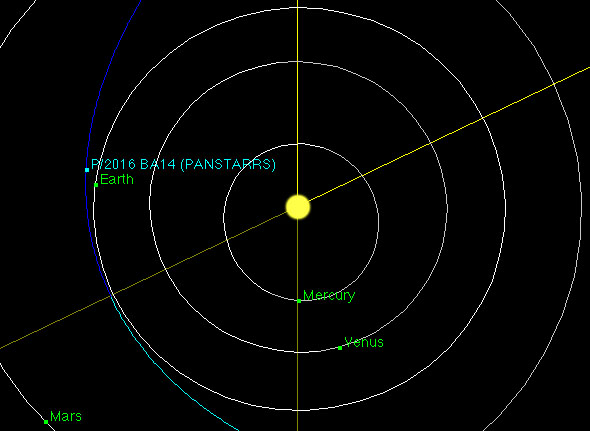
NASA / JPL
You'd have to go back to 246 years to find a comet that passed closer to Earth than Comet PanSTARRS 2016 (P/2016 BA14) will on March 22nd. Predicted to come within about nine lunar distances (2.1 million miles or 3.4 million kilometers) of Earth around 16:00 UT on that day, P/2016 BA14 will soon claim the distinction of third closest comet ever recorded.
Lexell's Comet has them all beat. It missed Earth by 1.4 million miles (2.2 million kilometers) on July 1, 1770. Although discovered in June that year by the comet ferret himself, Charles Messier, it became popularly known as Lexell's Comet after astronomer and mathematician Anders Johan Lexell computed its orbit. As the comet sprinted across the sky in late June and early July, Messier described the coma as more than four times the size of the full Moon and as bright as magnitude +2. Wow!
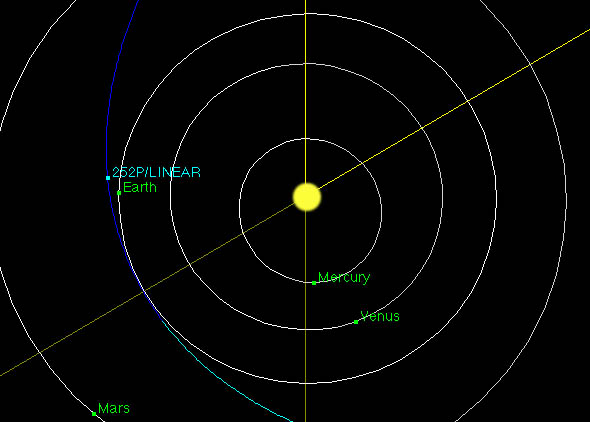
NASA / JPL
We'll see plenty of action from Comet PanSTARRS 2016 as it speeds from Canis Major to Ursa Major in the span of just 7 nights, but you'll need a telescope to spot it. When first discovered on January 21st of this year by the PanSTARRS 1 telescope, it was given an asteroid designation, 2016 BA14. Soon after, Russian astronomer Denis Denisenko noticed that it's orbit was remarkably similar to comet 252P/LINEAR, discovered in 2000 and on course for a similar close approach to Earth this month.
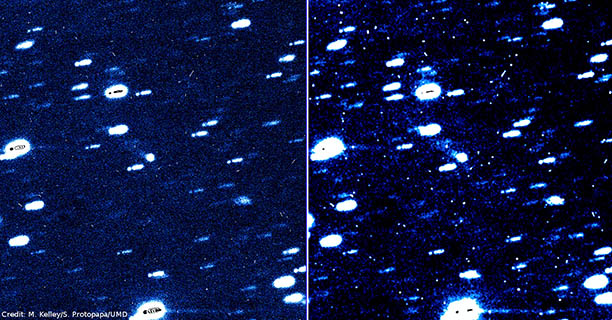
M. Kelley / S. Protopapa / University of Maryland
Could they be related? Astronomers Michael Kelley and Matthew Knight wanted to find out, so they observed 2016 BA14 with Lowell Observatory's Discovery Channel Telescope in February. Sure enough, their photos revealed a tail. Two comets on nearly identical orbits with nearly the same period of 5.32 (252P) and 5.25 years (BA14) imply a common origin. The most likely scenario? A chunk of 252P/LINEAR spalled off to become P/2016 BA14. The "P" designation stands for periodic and indicates that both comets make repeat orbits around the sun.
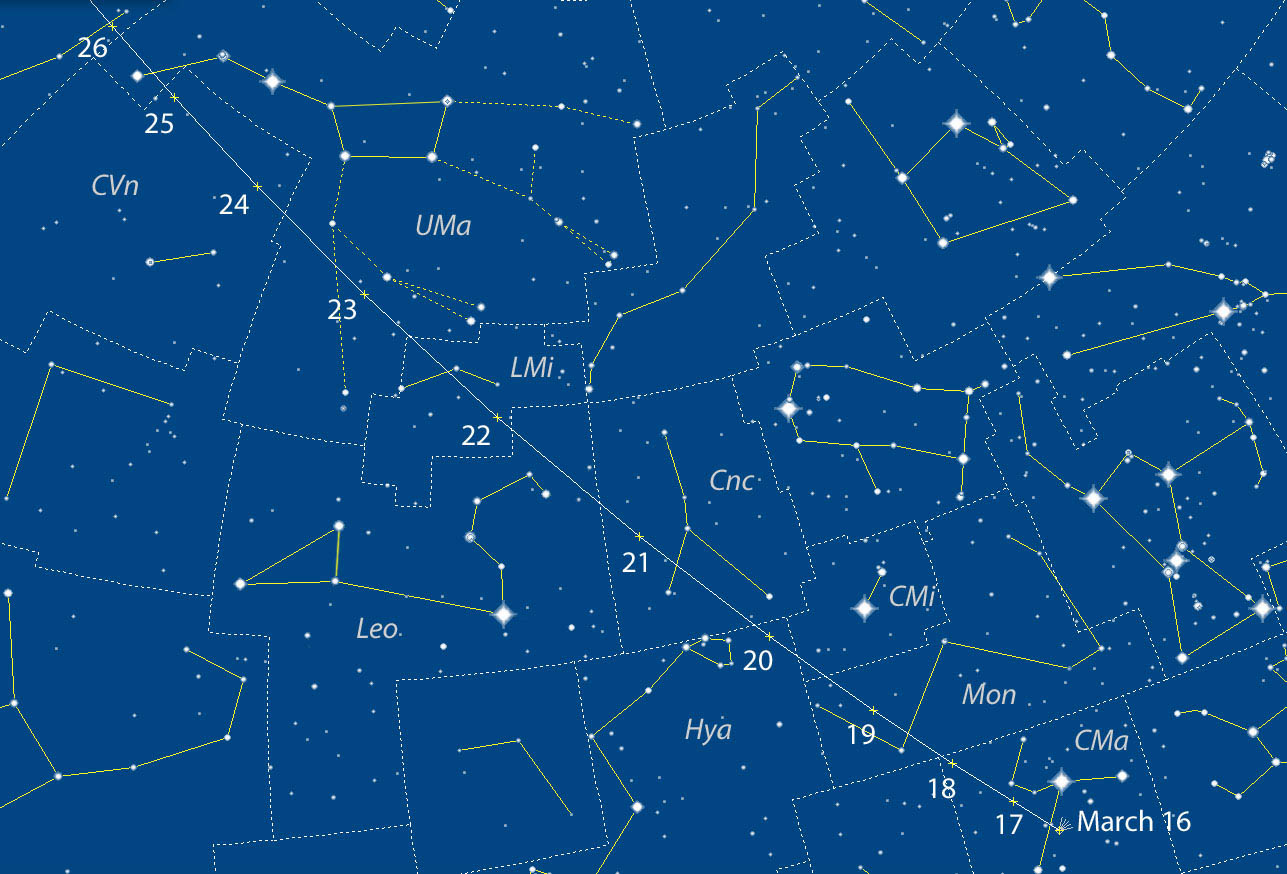
Chris Marriott's SkyMap
Surging rapidly towards naked-eye visibility, 252P/LINEAR has riveted the attention of the comet community but for now is only visible in the Southern Hemisphere. Hold onto your hats. It moves rapidly northward and will pop up in Scorpius' tail at 6th magnitude in about a week. In the meantime, its sibling is likewise headed north at rocket speed. Currently tiny and a pitifully faint 15th magnitude, P/2016 BA14 is expected to brighten rapidly and reach magnitude +12 during closest approach on March 22–23. I suspect it will also show a large coma, especially in long time exposure images.
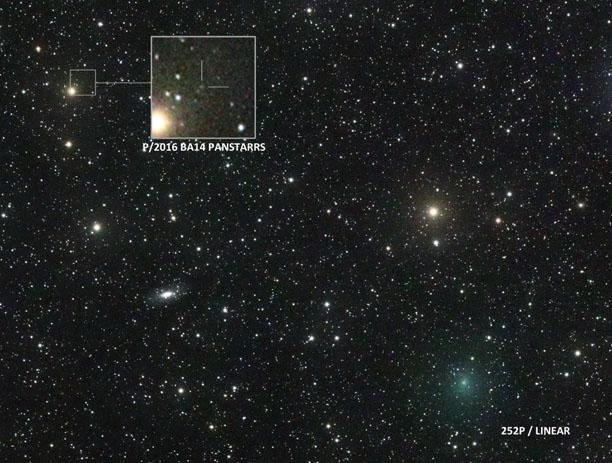
José J. Chambó
Although the full Moon will make a mess of things at that time, we get a break by the 24th when the Moon rises at twilight's end, allowing for a brief window of darkness. At that time, the comet will be beautifully placed, flying across Ursa Major at the rate of 13° per day or more than 1/2° per hour. Between March 21st and 22nd, it covers an incredible 20° in 24 hours, fast enough to detect motion in less than a minute through a telescope. Provided it brightens as hoped, that is.
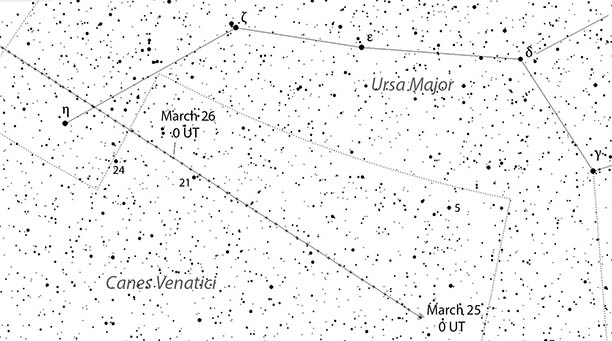
Chris Marriott's SkyMap
Although I've included a detailed map for March 25-26, I encourage you to visit the Small-Body Database Browser via the JPL HORIZONS Web-Interface, grab the comet's orbital elements, and create your own chart using a planetarium-style program such as Starry Night, Stellarium (free) or TheSkyX.
We'll soon know much more about these two unequal popsicle halves. Michael Kelley has secured time on the Hubble Space Telescope for a closer look at 252P. Spectra should help astronomers determine if the comets' compositions are similar enough to prove they're related. Radar observations are planned for BA14 using the Green Bank and NASA's Deep Space Network's DSS-13 dishes to determine the shape and size of its nucleus and other characteristics. Unfortunately, it appears that the 1000-foot (305-meter) Arecibo dish, which might have been used to image 252P, will most likely be down for maintenance during the flybys.
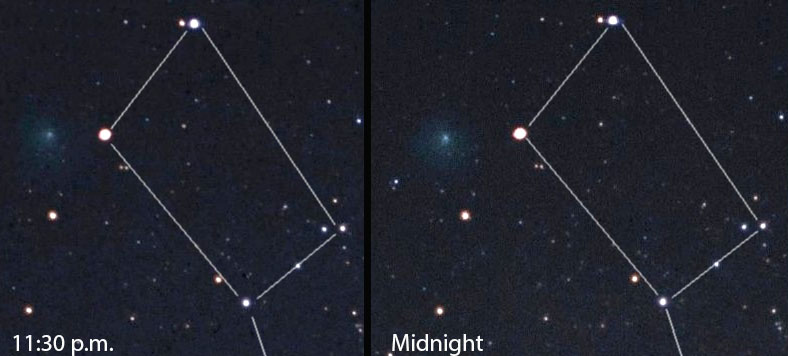
Jo-Ann Kamichitis
The Comet PanSTARRS 2016's rapid flight brings to mind another similar comet, the previous third-place holder (after Lexell's and 55P/Tempel-Tuttle in 1366) at 2.9 million miles (4.7 million kilometers), IRAS-Araki-Alcock, discovered in 1983. I recall the sight of a 3rd-magnitude, tailless blob of haze leap-frogging across the sky at the rate some 30° per night. Through the telescope, fascinating structures lit up the inner coma as the comet moved against the stars in real time. When I look back, I'm grateful for those three clear nights in a row during during closest approach ... and hoping for a repeat!
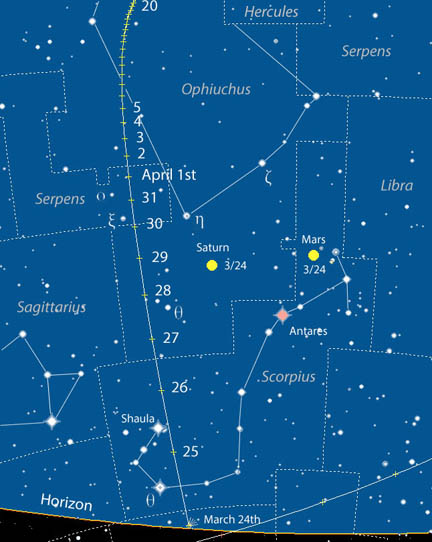
Chris Marriott's SkyMap
Whether you have a telescope or not, you'll still have an opportunity to see Comet P/2016 BA14 (Comet PanSTARRS 2016). Astronomer Gianluca Masi, who maintains the Virtual Telescope website, will broadcast a live telescopic image of the Comet PanSTARRS 2016's historic encounter on March 21st and 22nd starting at 21 UT (4 p.m. CDT). Sky & Telescope will also keep you updated with news, photos, and maps of both comets in the coming weeks.
 22
22









Comments
Edward Schaefer
March 16, 2016 at 12:58 pm
In the article, it says " Predicted to come within about nine lunar distances (21.4 million miles or 34.4 million kilometers) of Earth". Those numbers are more like 90 lunar distances. I suspect from what is written later on (about Lexell's Comet) that the numbers are a factor of 10 to high.
You must be logged in to post a comment.
Bob KingPost Author
March 16, 2016 at 1:19 pm
Hi Edward,
Thank you! A bad decimal point placement and since corrected.
You must be logged in to post a comment.
Nebulous
March 21, 2016 at 11:54 am
Hi, Bob.
As for looking for looking for this comet with a telescope, any hints on equipment, i.e. eyepiece focal length, magnification needed to see, etc.? I live in the Minneapolis area (CDT) and have a 5.1" reflector. Your tracking chart is excellent and I'm sure it will be helpful. Praying for clear skies this week!
You must be logged in to post a comment.
Bob KingPost Author
March 21, 2016 at 12:33 pm
Nebulous,
The comet still looks like a star of perhaps 13-14th magnitude though it may yet develop a small coma. So you'd be looking for a faint, star-like object moving slowly in real time across the field of view. A 5-inch might catch it under rural skies at mag. +13, but it would be a challenge unless the comet brightens further. I'll have an update this Weds. with (hopefully) a better idea of its brightness. Photos from March 20 show it as stellar. You'll have a much better chance to see 252P at ~6 mag. this weekend when it moves into Scorpius though moonlight will interfere. Still, a 5-inch should nab it no problem.
You must be logged in to post a comment.
Cartgirl
March 21, 2016 at 5:18 pm
I would love to see these comets...excuse my total lack of knowledge on this topic that fascinates me, but I live in Jackson, MI and would be so grateful to know when I can see them. I have spent hours online trying to find out unsuccessfully...can someone tell me...please...Laura
You must be logged in to post a comment.
Bob KingPost Author
March 21, 2016 at 10:19 pm
Cartgirl,
You will need a fair-sized telescope to see BA14, but 252P/LINEAR should be visible in binoculars from a moderately dark site from Jackson, Mich. starting Friday morning, though very low in the south before dawn). The comet climbs higher and gets easier to see starting Saturday morning. It will look soft and diffuse and not especially bright partly because of bright moonlight.You can use the map at the end of the article to help you find it. I will also have a choice of maps when we do an update this Weds. Come back then for more information. Thanks for writing!
You must be logged in to post a comment.
uh1hhuey
March 29, 2016 at 5:08 pm
Hi Bob just wanted to ask what you consider a fair-sized telescope? I have the Evolution 9.25" SCT is that something what would be able to resolve this comet and if I were in dark skies what do you think the limit of a scope that size might be. Thanks for all your great writings.
You must be logged in to post a comment.
Bob KingPost Author
March 30, 2016 at 12:51 am
Hi Huey,
Thanks! That sounds like a good-sized telescope to see the comet with. The moon's the real problem right now. If you wait a couple more days till about April 1, you should be able to find the comet with ease in your 9.25". It's still around 6th magnitude as of March 28. Good luck!
You must be logged in to post a comment.
Tom Hoffelder
March 17, 2016 at 11:45 am
This is a very interesting and very well written article, but as far as observing comet close encounters, I'm going to stick with my memories of IRAS-Araki-Alcock. On the evening of 5/10/83, I took a photo of it (which means it was easy naked eye) just west of the Big Dipper's bowl. My photo taken the following evening shows the comet slightly east of the Beehive. In those 24 hours, the Minor Planet Ephemeris Service (MPES) lists the comet's average sky motion to be 108 arcsec/min, indicating it moved twice as far in the one day of closest approach as 2016 BA14 will, which is obviously due to Earth/comet relative motions. 2016 BA14 appears to be following the magnitude predictions of MPES, which shows 12.9 to be the maximum. By the time the moon is out of the way (the 25th for me), the ephemeris lists 13.9 for the magnitude. Considering 252P, the first morning it is above the horizon (only 5 deg) before the beginning of twilight here in Maine is the 25th, by which time the moon has entered the morning sky. And by the 31st, with the moon still a problem at 3rd quarter, 252P is predicted to have plummeted to 12th magnitude.
You must be logged in to post a comment.
Bob KingPost Author
March 20, 2016 at 11:01 am
Thanks Rocksnstars! I hope 252P hangs in there and doesn't do a full reverse so soon after perigee.
You must be logged in to post a comment.
Rick-Scofield
March 18, 2016 at 4:29 pm
Hey as far as I am concerned its always fantastic to see a comet this close regardless of records. Great article and thanks for the tracking detail.
You must be logged in to post a comment.
Bob KingPost Author
March 20, 2016 at 11:02 am
Hi Rick,
You're welcome and thank you. I hope you spot both comets.
You must be logged in to post a comment.
speeedy23
March 19, 2016 at 11:15 am
In the image in the USA Today article, there is a third similar object behind the two in the foreground, much more distant. It also has a fuzzy green halo, like the other two, indicating that it is probably another comet fragment. Why is no one discussing this?
http://www.gannett-cdn.com/-mm-/1e829e7c11a50c7744f1be16deda150dc9f0b2b9/c=62-0-734-505&r=x404&c=534x401/local/-/media/2016/03/18/USATODAY/USATODAY/635939089266796832-XXX-20160318-USA-APS-0037.JPG
You must be logged in to post a comment.
Bob KingPost Author
March 21, 2016 at 11:50 am
Speeedy23,
What you're seeing is a composite photo in USA Today showing the comet getting larger as it gets closer. Just one comet there. The other comet, P/2016 BA14, is in another part of the sky entirely.
You must be logged in to post a comment.
speeedy23
March 21, 2016 at 10:30 pm
Thank you.
You must be logged in to post a comment.
March 19, 2016 at 1:59 pm
I, too, remember the tailless IRAS-Araki-Alcock racing across the rural Kansas sky during a succession of lovely May evenings. The huge, diffused coma was several times the apparent size of the full moon; using an 11x80 binocular, its motion against faint background stars was evident within a minute. The perfect confluence of mild springtime temperatures, clear skies and the complete absence of moonlight made its apparition an unforgettable experience.
You must be logged in to post a comment.
jonkjon
March 19, 2016 at 3:29 pm
The article mentions "Although I've included a detailed map for March 22-23 ...", however, the map shows dates for March 25-26. I assume that the map is correct since the moon will be better placed for observation of P/2006 BA14. A\m I misreading something?
Either way, great article! Thanks!
You must be logged in to post a comment.
Bob KingPost Author
March 21, 2016 at 11:53 am
jonkjon,
I appreciate you pointing this out. Yes, the map is correct, since it shows the comet post-full moon when it might be more easily visible. My mistake on the date reference in the text. It's corrected now and matches the map date. Thank you!
You must be logged in to post a comment.
TJCarter
March 19, 2016 at 10:41 pm
It's fun seeing all these references to IRAS-Araki-Alcock -- that was my first-ever comet. I didn't realize then just how remarkable it was to see such distinct movement over so short a time span. I was still thinking of comets as slow meteors! (I'm still embarrassed by my early observing notes -- but I'm glad I took them!)
You must be logged in to post a comment.
Randall Osczevski
March 20, 2016 at 3:46 pm
In the past, several observers have reported celestial objects that were uncomfortably close to our planet, judging by the rapidity of their motion across the sky. An astronomer in Grahamstown, South Africa named Eddie, observed a fast-moving comet on October 27, 1890. It was visible for three quarters of an hour and moved through 100 degrees of sky (Nature 43-89, 90). Professor Copeland reported seeing another fast-moving comet on Sept 10, 1891 (Nature, 44-519). Dreyer (Nature, 44-541) saw the same object, which he likened to Eddie’s Comet, from Armagh Observatory.
I have to wonder if anyone knows where Eddie's Comet is now, and when it might pass this way again.
You must be logged in to post a comment.
Michael Gerver
March 21, 2016 at 9:24 am
The two maps for BA14 seem to be inconsistent with each other, and one of them must be labelled wrong. The one that shows the path of BA14 from March 16 to March 26 shows it passing close to Eta Ursae Majoris (the last star in the handle of the Big Dipper) on March 25 at about 10:00 UT. But the more detailed map showing its position on March 25 and March 26 shows it passing close to Eta Ursae Majoris on Matrch 26 at 10:00 UT. Which one is correct?
You must be logged in to post a comment.
Bob KingPost Author
March 21, 2016 at 12:18 pm
Hi Michael,
Both maps are correct. The wide map shows the comet's position for 9 p.m. CDT just to give a flavor of its rapid motion across the sky. For the detailed map, I chose UT time because it's more "universal".
You must be logged in to post a comment.
You must be logged in to post a comment.